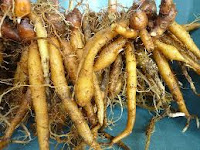FINGERROOT, KRA CHAI, BOESENBERGIA ROTUNDA
Fingerroot is used in China Thailand
It is also known as Curcuma rotunda, Gastrochilus rotundus and Boesenbergia pandurata. It has a spicy flavour and is eaten in Thailand Asia and has naturalized in many countries. The leaves are edible as is the root and rhizome, and medicinally it has been employed for many purposes in traditional medicine systems in India Malaysia Indonesia Indonesia
 In the West this plant is grown as an ornamental as it has attractive pink flowers and is aromatic. The finger-like roots are bright yellow and their aroma comes from the camphor, methyl cinnamate, d-borneol and 1-8 cineol mainly although there are also other aromatic substances in them.
In the West this plant is grown as an ornamental as it has attractive pink flowers and is aromatic. The finger-like roots are bright yellow and their aroma comes from the camphor, methyl cinnamate, d-borneol and 1-8 cineol mainly although there are also other aromatic substances in them. The crushed roots and rhizomes are applied to painful parts of the body to ease rheumatic pains, and they are used internally to dispel flatulence, improve the appetite and digestion, as a remedy for dry mouths, coughs and ulcers. After giving birth a post-partum tonic is prepared from them and a paste may also be made from the roots and applied externally to the body after childbirth. The paste is also applied to piles and a lotion made from them is used for rheumatism, and muscle pains. They are also used for diarrhoea and dysentery.
 In
In Scientific evidence suggests that the roots may have anticancer properties, and research is still underway on these properties. They are also believed to have analgesic (mild pain relieving) properties, as well as antibacterial, antifungal, antipyretic, anti-inflammatory, antispasmodic and insecticidal properties.
There have been investigations which suggest that the flavonoids in the roots can prevent an occurrence of dengue fever (Biorganic and Medicinal Chemistry Letters Vol. 16 (12) June 2006 pp.3337-40).
 Its anti-ulcerogenic properties have also been tested and found to be supported (“The methanolic extract of Boesenbergia rotunda (L) Mansf. and its major compound pinostrobin induces anti-ulcerogenic property in vivo: Possible involvement of indirect antioxidant action”, Siddiq I. Abdelwahab et al. Journal of Ethnopharmacology, July 2011).
Its anti-ulcerogenic properties have also been tested and found to be supported (“The methanolic extract of Boesenbergia rotunda (L) Mansf. and its major compound pinostrobin induces anti-ulcerogenic property in vivo: Possible involvement of indirect antioxidant action”, Siddiq I. Abdelwahab et al. Journal of Ethnopharmacology, July 2011). Its anti-cancer properties were documented in a study by Chandra Kirana et al in the Journal of Natural Medicine Vol. 61 (2007) pp. 131-137 “Anticancer properties of panduratin A isolated from Boesenbergia pandurata (Zingiberaceae)” which concluded with the statement that this “may have a protective effect against colon cancer” but it needed further investigation for this claim and to ascertain if it was effective against other types of cancer cells particularly those of breast cancer.
 In 2011 Shiau-Chuen Cheah et al showed that the tests were valid in an article “Panduratin A Inhibits the Growth of A 549 Cells through Induction of Apoptosis and Inhibition of NF-KappaB Translocation” published in Molecules, 2011 Vol.16 pp.2583-2598.
In 2011 Shiau-Chuen Cheah et al showed that the tests were valid in an article “Panduratin A Inhibits the Growth of A 549 Cells through Induction of Apoptosis and Inhibition of NF-KappaB Translocation” published in Molecules, 2011 Vol.16 pp.2583-2598. Research is still continuing into this Chinese medicinal herb.



